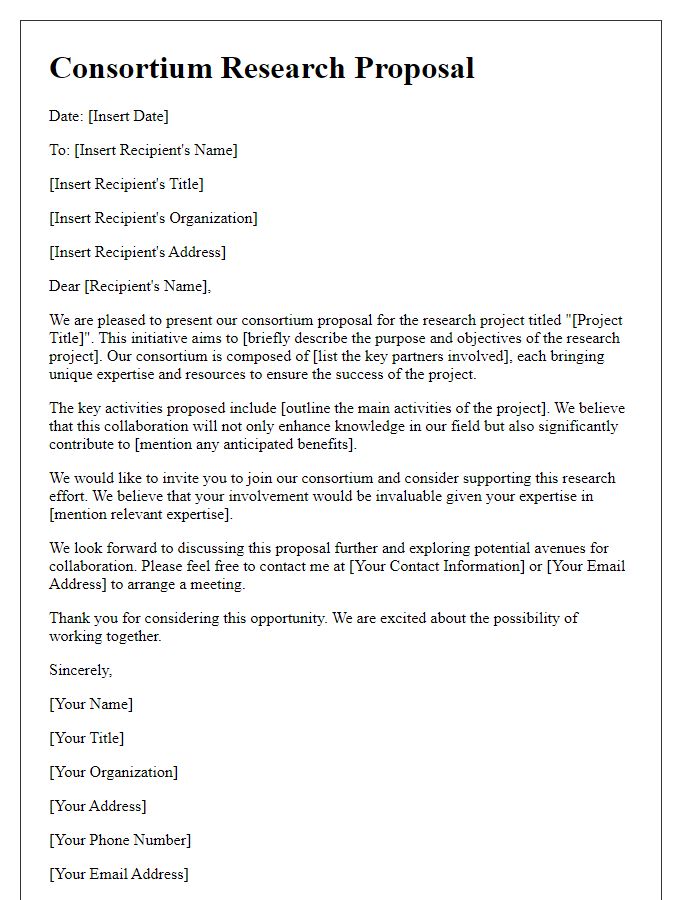Are you looking to forge meaningful research partnerships that drive innovation and impact? Collaborating with like-minded institutions can open doors to resources and insights that amplify your project's potential. In this article, we'll explore how to effectively craft a letter that not only articulates your vision but also engages potential partners in a compelling way. Read on to discover essential elements that can make your partnership proposal stand out and succeed!

Clear Objectives
Developing a research partnership requires clear objectives to ensure alignment and successful collaboration. Establishing a mutual understanding of research goals, such as enhancing data accuracy or advancing scientific knowledge within specific fields like biotechnology or environmental science, is essential. Identifying key milestones, such as publication deadlines or funding application submissions, can further streamline efforts. Each partner's role should be defined clearly, encompassing responsibilities in data collection, analysis, and dissemination to foster accountability. Furthermore, a regular communication schedule can enhance collaboration and ensure that objectives remain on track, adapting when necessary to emerging findings or challenges. Establishing these clear objectives will provide a foundation for a fruitful partnership that drives meaningful results in the research community.
Mutual Benefits
A research partnership focused on mutual benefits can enhance innovation and knowledge exchange between institutions. Collaborative efforts typically yield improved access to funding sources, such as government grants or private sector investments, potentially amounting to millions of dollars in support for joint projects. Sharing resources, like specialized laboratory facilities found in leading research centers, enables both parties to advance their research capabilities effectively. Access to diverse expertise from different disciplines fosters groundbreaking findings, influencing fields such as biotechnology or renewable energy. Additionally, joint publications in reputable journals, like Nature or Science, can elevate the profiles of both institutions, attracting top-tier talent and new opportunities for future collaboration.
Key Stakeholders
Key stakeholders in research partnership development play critical roles in shaping the success of collaborative projects. These stakeholders typically include academic institutions, such as universities with expertise in relevant fields, governmental agencies that provide funding and regulatory support, and private sector companies seeking innovation. Non-profit organizations can also serve as vital partners, often facilitating outreach and engagement with communities. Each stakeholder brings unique resources, such as laboratory facilities, industry insights, or access to specific populations for research, creating a comprehensive ecosystem for advancing knowledge and technology. Identifying and engaging these key stakeholders early in the process allows for aligned goals, optimized resource allocation, and increased impact of research initiatives.
Timeline and Milestones
Establishing a research partnership involves key timelines and milestones that ensure effective collaboration. For instance, initial discussions may commence in January 2024, focusing on identifying common interests and research goals. Following this, a memorandum of understanding (MOU) could be drafted by March 2024, outlining the terms of collaboration. By June 2024, both parties may agree on specific research projects, leading to a pilot study launch in September 2024. Subsequent progress reviews could be scheduled quarterly, with a major assessment planned in December 2025 to evaluate project outcomes and impact. Final project deliverables and publications may be targeted for completion by March 2026, culminating in a workshop to present findings and future directions in April 2026.
Legal and Ethical Considerations
Developing research partnerships involves navigating complex legal and ethical considerations, particularly relating to data protection laws, intellectual property rights, and compliance with ethical review boards. Organizations must adhere to regulations such as the General Data Protection Regulation (GDPR) in Europe, which mandates informed consent and the safeguarding of personal data, especially in health-related research. Intellectual property laws protect inventions and innovations created during the partnership, necessitating clear agreements outlining the ownership and usage rights of generated intellectual property. Furthermore, ethical considerations encompass ensuring equitable treatment of research subjects and maintaining integrity in data collection and reporting practices. Engaging with Institutional Review Boards (IRBs) or Ethics Committees is essential to ensure all research activities align with moral standards and community values.













Comments